The story of St. Matthew’s Roman Catholic Church through the eyes of three Buffalonians connected to the house of worship
BUFFALO, N.Y. — The pigeon shit is everywhere.
It’s in the belly of the church, beneath the cracked cathedral ceiling, carpeting the floor of the nave where wooden pews once stood. It’s in the choir loft.
On a narrow flight of steps ascending skyward to the bell tower, the droppings have accumulated in a lining several layers thick.
The bell is missing. The pigeon shit is gray.
It didn’t used to be like this.
Once, the chanting of prayers filled these chambers. The Apostles’ Creed floated, in dutiful whispers, from the lips of parishioners.
I believe in the Holy Spirit, the holy Catholic Church, the communion of saints, the forgiveness of sins…
People came here, seeking hope.
But that was many years ago.
The last mass at St. Matthew’s Roman Catholic Church on Moselle and Ferry Streets took place on March 3, 1993.

Today, it’s the house of worship that needs saving.
On a winter afternoon, wind drifts in through broken windows, murmuring to no one in particular. The organ sits in pieces. The white walls crumble at the touch.
• • •
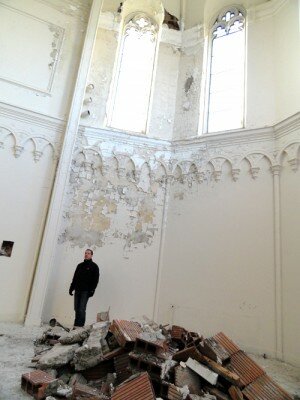
Amid the rubble: David Torke of fixBuffalo | Charlotte Hsu
David Torke steps into the wreckage.
He has been here before, on a dozen other occasions, maybe. He knows these broken ceilings, these splitting walls. The gold-hued angels gazing down from atop Corinthian columns are old friends.
Torke, a community advocate, has been documenting Buffalo through photographs for 17 years.
St. Matthew’s, where he is standing now, is one of several city landmarks whose decay he has chronicled on his blog, fixBuffalo. His images of the church possess the kind of twisted, apocalyptic beauty that charms urban explorers.
But Torke, 48, is no gawker.
He has lived on the East Side, on Woodlawn Avenue in the Cold Springs neighborhood, since 1994. His photography is a form of activism.
He created fixBuffalo in 2004 to try to save the vacant Woodlawn Row Houses near his home. He wrote about the cream-blue dwellings more than 40 times before they burned in 2009.
He has also posted on St. Matthew’s on a dozen occasions.
“Guess you know a church is headed for the dust pile when you see old pews used as boarding material for broken windows,” he said in one 2007 entry.
Sounding more hopeful two years later, he called the property “a truly amazing space that’s ripe for the right person to pound into a creative live/work space.”
St. Matthew’s is part of a world that Torke, a native of East Aurora, began discovering in the late 1980s, when he returned to Western New York after studying in Germany and Vermont.
As white families left the East Side en masse, he moved in.
He saw history in Buffalo’s architecture: the DNA of a great city. Where others saw blight, he saw the future.
He argued for the rescue of houses and monuments that other people thought were beyond repair. He questioned delinquent landlords and posted the interviews on fixBuffalo. News reporters began to call, seeking insight on the forgotten sites he dreamed of resurrecting.
St. Matthew’s is one of those relics that Torke believes can be saved.
On a freezing winter day, he stands in the nave, telling the story of the church—how the Diocese sold the edifice in the 1990s to World Wide Bible Deliverance Inc., a religious outfit that failed to maintain the building; how the property eventually ended up on public auction in 2006; how the new buyers then tried to unload St. Matthew’s via eBay almost immediately.
Torke played a part in stopping the sale, publicizing the issue on his blog and alerting the city’s Anti-Flipping Task Force, which persuaded the owners to delete their eBay listing.

The ruins | Charlotte Hsu
In the sanctuary, where priests once presided over ceremonies, a jumble of cinderblocks forms a trash heap several feet wide. The guts of the building are on display, giving the place an inside-out feeling.
Still, he would love to convince the staff of a design magazine like Dwell or Metropolis to sponsor a competition soliciting proposals for repurposing the church.
His own idea is avant-garde: Construct a heated, winter house in the center of the nave, and convert the organ loft into a summer dwelling.
Torke doesn’t own the place, of course, so he can only imagine.
Meanwhile, clumps of pigeon stool and dust gather downstairs, upstairs, everywhere. Stained glass windows are missing. A few, including ones depicting The Nativity and The Annunciation, have somehow made their way to a Catholic church in Fargo, N.D.
In the waning light of the afternoon, Torke exits St. Matthew’s. He has visited many times before, and he will probably be back again.
But for now, he shuts the door on the beauty and the ruin of the place—on the peeling walls, the painted ceilings, the solemn angels and the fall from grace.
• • •
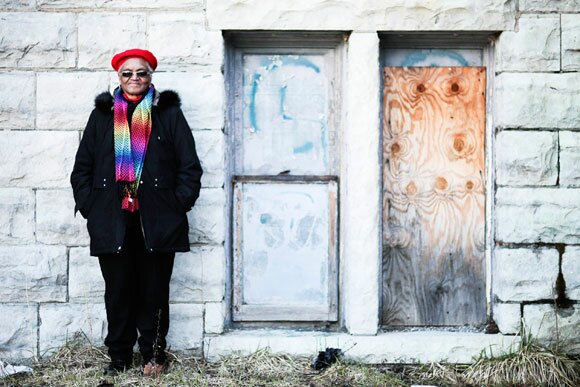
Alice Davis | Christina Shaw Photography
In her mind, Alice Davis can resurrect St. Matthew’s.
She can hear the the choir. She can conjure the faces of fellow parishioners, who packed the pews on Sunday mornings. She can see the lights and red poinsettias that ornamented the church for midnight mass.
“Beautiful,” she remembers.
In those years, the edifice of ochre sandstone was still something grand. No one had broken the windows yet. No one had stripped out the stained glass.
Davis, a native of Georgia, moved to Western New York in 1955, joining the Great Migration of blacks from the segregated South to the industrial cities in the North and West.
She settled first in Niagara Falls, where she met her future spouse, Theodore, a soldier. After marrying in 1957, the couple moved to Buffalo, a humming city of restaurants, boutiques and jazz clubs that Davis found more exciting than Atlanta.
The family soon grew to include a daughter and two sons. To help support the children, Davis worked as a waitress at a Woolworth’s lunch counter. She also converted to Catholicism, her husband’s religion.
In the early 1980s, the Davises bought a house on Moselle Street, across from St. Matthew’s, where they began attending weekly services.
Their godchildren were students at the associated Catholic school. Later, it was beneath the church’s high, arched ceilings that loved ones comforted Davis at Theodore’s funeral in 1987.
Davis remained a congregant at St. Matthew’s until 1993, the year it closed due to dwindling membership.
One day, she heard noises inside the building: Tap, tap, tap. Soon after, she noticed that much of the stained glass was gone. Kids from the neighborhood threw rocks at the church. Weeds in the surrounding garden grew high.
For the most part, no one came to fix the problems.
“I feel a certain attachment to St. Matthew’s, because when you see something that was so beautiful, and now, I look at it and it’s just destroyed beyond repair, it just makes me feel sad,” Davis says. “Really, really sad.”
“If I didn’t have to open my window and look at it every day, maybe that sadness wouldn’t be there,” she continues. “But when you watch something deteriorate right before your eyes, it makes it sad, because you know what it was like before.”
Davis, 75, says the only solution now may be to demolish St. Matthew’s. She toured the interior last year, and judges that it was “totally destroyed.” The piles of rubbish and junk strewn across the nave made the place look like a war zone, she says.
A succession of owners, beginning with the Diocese—and, really, with the congregants—abandoned the old church.
Davis wonders who is left to care—who has the money and passion to make St. Matthew’s beautiful again. Maybe no one. Maybe someone, somewhere out there.
• • •
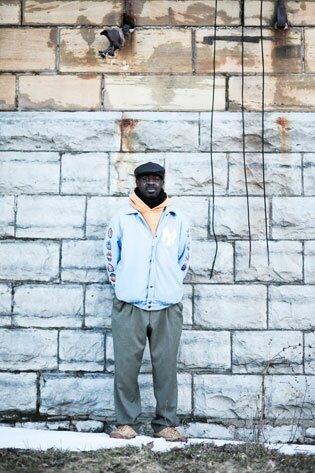
Frank Beard | Christina Shaw Photography
The man who holds the deed to St. Matthew’s is Frank Beard, a local resident who acquired the property in 2009 from the folks who had tried to flip it on eBay.
Beard, 46, grew up on nearby Schuele Avenue, where his mother still lives. He says he was helping with a neighborhood cleanup a couple years ago when he ran into one of St. Matthew’s owners, who seemed eager to get rid of the church.
Beard volunteered to take it over, and a little paperwork later, the architectural treasure was his.
Last year, he helped organize an Easter egg hunt on church grounds. This June, he says, he will plant 10 trees that bloom with white flowers on the premises.
He envisions St. Matthew’s as a community center, with a playground in the choir loft, an eatery in the basement, and a stage for gospel music and lectures on health, education and other topics in the nave.
But Beard needs money to make that happen, and he hasn’t held a job for about a decade. Government assistance is his only income. He hasn’t worked since hurting his spine while laboring in a warehouse years ago.
Funding for St. Matthew’s renovation will have to come from somewhere else.
Shortly after acquiring the church, Beard completed Empire State Development’s three-month Entrepreneurial Assistance Program, hoping to pick up skills that would help him win a start-up grant from the Buffalo Economic Renaissance Corporation.
But before the classes ended, he says, the scandal-ridden city agency told participants it would not be disbursing financial assistance.
A core element of Beard’s new fundraising plan is the sale of hoodies and other clothing featuring cartoon characters he has drawn, including Grandmaster Blast, head of a cartoon R&B gospel group.
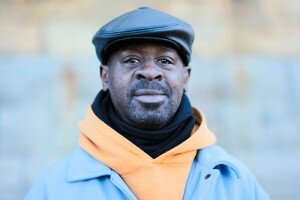
Frank Beard | Christina Shaw Photography
He has some experience in community organizing: He campaigned, as a volunteer, for health care reform, and sits on the board of the Citizens Alliance, a small nonprofit that has helped Delavan-Grider-area residents improve their homes.
But turning St. Matthew’s around will require a small fortune, and Beard can’t even keep up with property taxes.
He is $1,654.72 behind on payments that have accumulated over three years. To cover the cost of new paint and wall lights, he says, he scrapped the church’s radiators. (Thieves had stolen the furnace.)
Beard has also failed to fix basic problems—including removing debris and repairing broken windows and gutters—for which the city inspector has cited a string of owners.
Still, “I feel like that building came to me for a reason,” says Beard, a born-again Christian. “I believe that something’s going to happen with that building.”
He has seen other decrepit structures in Buffalo come back to life.
He thinks it can happen again.
But for now, the only visible change at St. Matthew’s is a homemade, wooden billboard he nailed onto a sign on the property’s front lawn.
In a large, black letters, the makeshift placard reads:
Frank M. Beard
Recreational and Training Center
Knowledge Is Only Powerful When Put To Used…. Amen!
• • •
Today, the Catholic population of the eight-county Catholic Diocese of Buffalo is 633,550, a steep drop from a peak of 948,669 in 1969.
St. Matthew’s, founded in 1908, is one of 14 worship sites the Diocese shut down in the 1990s.
An additional 77 have closed since 2005, when the Diocese announced the Journey in Faith and Grace, a parish “revitalization and reorganization” program.
Some abandoned churches have found a new purpose.
Our Lady of Lebanon in Niagara Falls is on track to become a chocolate museum. A parish in Norcross, Ga. is raising money to buy, dismantle and move St. Gerard’s, another East Side church, to suburban Atlanta.
Other churches, like St. Matthew’s, have been left to rot.
Opinions differ on whom to blame.
Some people point to the Diocese, some to the city. Others fault the congregants, the families who deserted Buffalo when they migrated to the suburbs or left Western New York years ago.
Whatever the case, the more difficult question for St. Matthew’s may be the one that lies ahead: What comes next?
With each wasted year, the old house of worship falls further into disrepair.
Rain blows in through broken windows. Thieves scour the carcass of the church, carrying off anything of value. Paint flakes from the walls.
The pigeon droppings continue to pile up.
Special thanks to David Torke of fixBuffalo for introducing us to St. Matthew’s. Thanks, also, to Kevin Keenan of the Diocese for correcting us on the use of the word “basilica.” Basilicas (of which there are two in the Diocese of Buffalo) are so designated by the Vatican. St. Matthew’s is not one of them.
Robert Salonga, a crime and public safety reporter for the Contra Costa Times in the San Francisco Bay Area, edited this story.


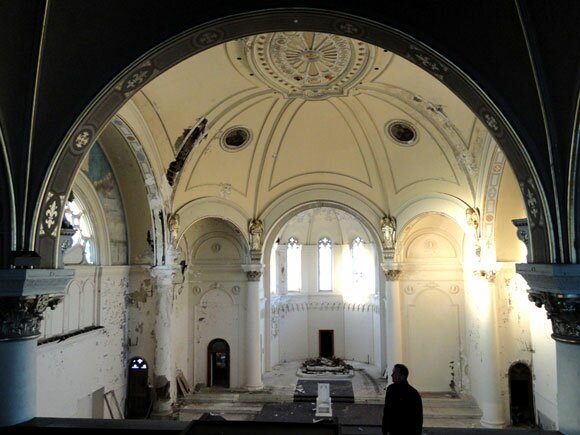





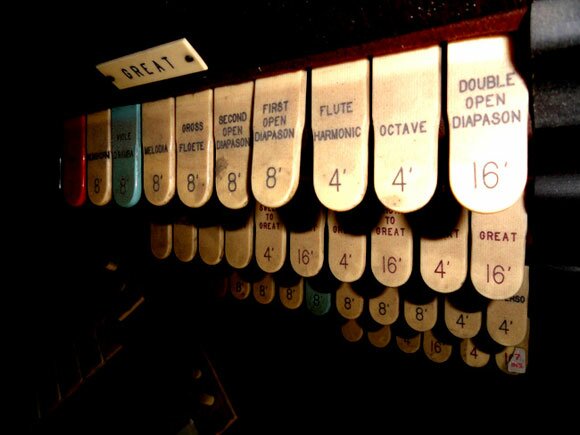



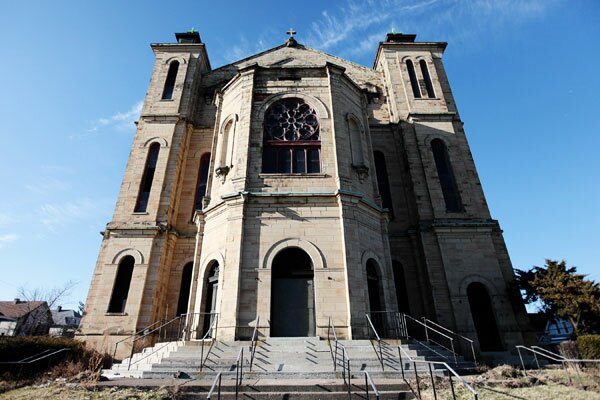




In some ways I think it is a non-starter to even look for someone, something, or some reason to blame for what is happening here. The life and death of a structure is an organic thing. A process from beginning to end. An accelerated process especially in American culture, which does not have the length and breath of history as found in much of Europe or Asia, there simple isn’t a strong value for the preservation of a anything (a structure) that has lost it’s utilitarian purpose. Perhaps, given the circumstances this building exists within, it’s just it’s time.
Thanks for weighing in. There are certainly many different opinions out there about what should happen. I think the culture of every city/place is different. In Vegas, where I was before moving to Buffalo, demolition was the norm. We blew up our old buildings in grand fashion and built a new history on top of them: http://www.lasvegassun.com/history/implosions/
But what works in one city might not work in another. I’d love to hear the thoughts of other readers. Thanks for sharing yours.
I have to disagree with Rich’s comment above. There are many, many examples of successful adaptive re-use situations involving churches in Buffalo alone: Babeville, King Urban Life, Karpelis Museums, etc. These buildings might lose their original purpose as places of worship, but can and should remain vibrant, vital community centers for education, the arts, etc. I hold on to the hope that someone will find a re-use scenario for St. Matthews.
To clarify, I’m all for adaptive reuse of existing structures. I’m also for the preservation of our heritage and history. However, if the community a structure exists in simply does not have the motivation nor the means to find a purpose with which to re-task this structure, then all the lamentations and recriminations are for naught! And I was simply stating an observation that America is a relatively young country without a strong sense of it’s own history and a corresponding value towards preservation.
Thanks for your words,do you know anyone who can help with donation for the reuse this church…For an outreach center call Kings and Queenscomplex center is the new name your donation are needed please and THANK YOU…
Pingback: Where is Journalism Headed? Who is a journalist? | West Side Local
This is a great job and thank you for keeping things as possible as you could thank your a lovely young lady…i belive the fundraising will go and all goals will be met…know anybody who help me with clothing line…Dropshipping needs…
Hey Frank, I bet if you printed up some sweatshits that said St. Matthews in blue and gold, like the students used to wear,we would buy them, I know I would.
There is another excellent example of church re use. The Buffalo Religious Arts Center is located in the former St Francis Xavier Church which was closed by the diocese in 2007. The building is being used as a museum to display and restore art work from the 70 shuttered churches in Western New York
So far the Art Center has collected statues, stained glass windows and altar furnishings from these closed places of worship and the interior design of the church itself remains intact. The interior murals are as they were in the early 1920″s
See photos on the website at
http://www.buffaloreligiousarts.org
This is a topic that seems to continually evoke a plethora of emotions from the ardent preservationist to the urban renewest and both, typically, make a strong argument of pro verses con.
I am a preservationist at heart and, with that being said, I know that just about any building can be saved which has been repeatedly proven in Buffalo beginning with the Webb Building to the most recent which is the former St Vincent’s Orphanage. Both buildings, I would have believed at one time, were so severely compromised that I would have thought demolition would be the end result. I am glad that I was proved completely wrong on both accounts.
St Matthews is a double tragedy as it is also a victim of economic loss located in an area comprised of apathetic individuals or perhaps, individuals too poverty stricken to be concerned about another piece of the urban decay that epitomizes their world.
I am at a loss as to a solution but I would think with funds being readily available for “emergency demolition” should become the same funds designated for basic maintenance of architecturally significant buildings not quite ready for restoration.
Pingback: The Plight of St. Matthew’s « Buffalo Rising News « Buffalo 123
I grew up in St. Matthew’s. It is my ideal, my heart. I have searched for word of its fate at other times. This finding saddens me. My mom called me when they closed her down. It was the church, so full of love, that rang with whisper of angel’s wings. You could feel them in the air. I was told, as a child, St. Matthew’s was built with volunteer labor. That German immigrant master stone cutters gave their work as a labor of love. The stained glass (OMG! WHERE ARE THE WINDOWS??) entertained me for years as a child. I looked up, in wonder, at the Face of God. This church defines my faith – this remembered church, still glorious and glowing with light, with COLOR!, with song. It is painful to see it this way. Painful.
Your words touched my heart as I read your post and I am elated to tell you that our church, The Way Christian Community, has purchased the former St. Matthews building. We already have some people and resources lined up and we are prepared to face the challenge of bringing this beautiful structure (and the surrounding community) back to life:)! We hope to have our first service this Easter Sunday April 20th, and we do hope that you would be able to join us. Please continue to pray for us as we head down this road on our journey of love. God’s peace be with you.
I was baptized at St Matthews as was every member of my family. We lived close by and all 7 of us kids attended school there. I was alter boy, most likely the best they ever had. Right. i’m Irish.
Had lots of german neighbors. We left in 1969, the house we lived in is a vacant lot now. We moved out to kenmore after the riots. went back a few times but we no longer welcome in our old neighborhood. Dad sold the house for a dollar. Years later.
Seen Father Keymeir years later, never did forget Sister Hildagard or as she later became sister Gurtrude. Never forgot that came from russia and played the piano, that was magic.
Good by St Matthews, played great dodgeball there. Graduated from Kenmore West and went into USAF. 8th air force. I married a girl from singapore and live in Oregon now, I do miss Buffalo. Zenner street, me humble home
Went to School there and made my First holy communion at this church…Recently found all my old records from the Church and The school…Would be interested in coming back to Buffalo and taking a look….I lived on East Ferry about 6 houses down across from an old supermarket,,,any info on how to take a look and help out please E-Mail me